Question Number 69741 by ajfour last updated on 27/Sep/19
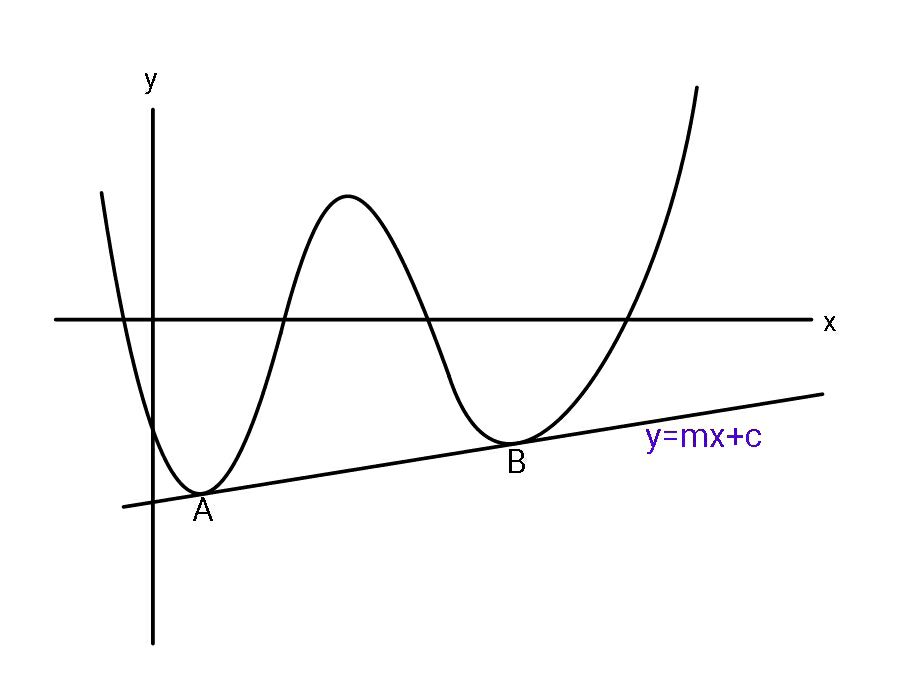
Commented by mr W last updated on 27/Sep/19
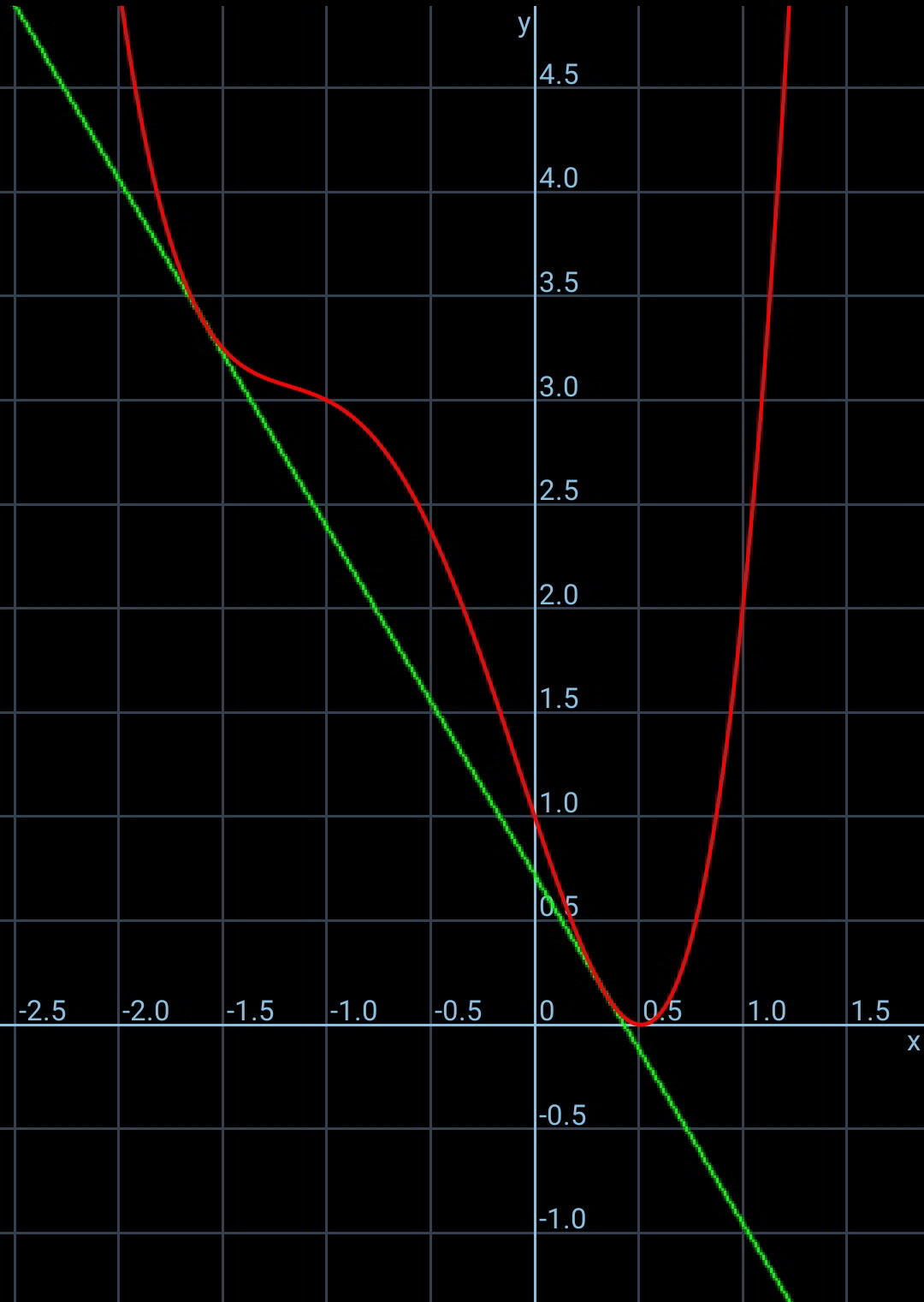
Commented by mr W last updated on 27/Sep/19
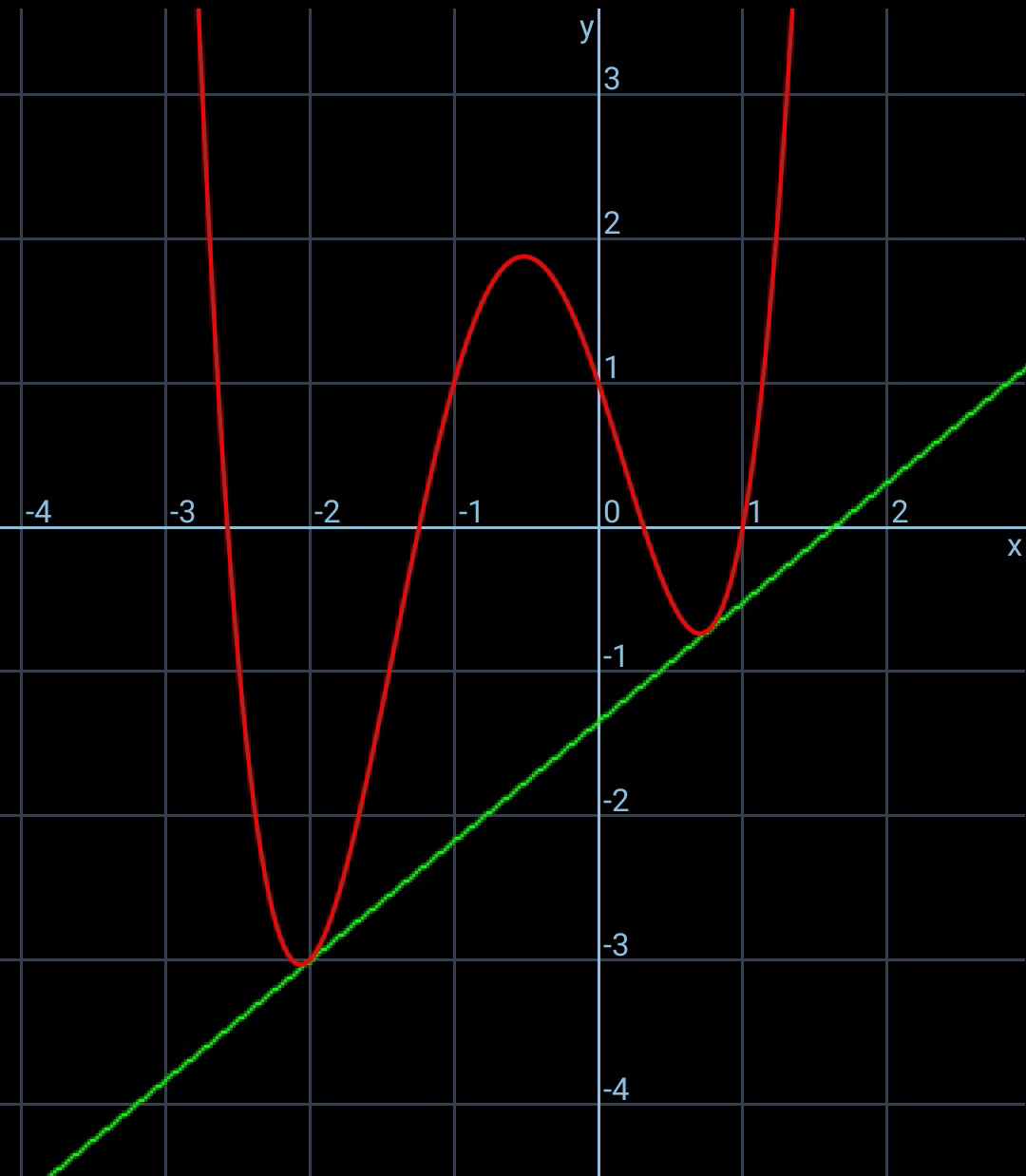
Commented by mr W last updated on 27/Sep/19
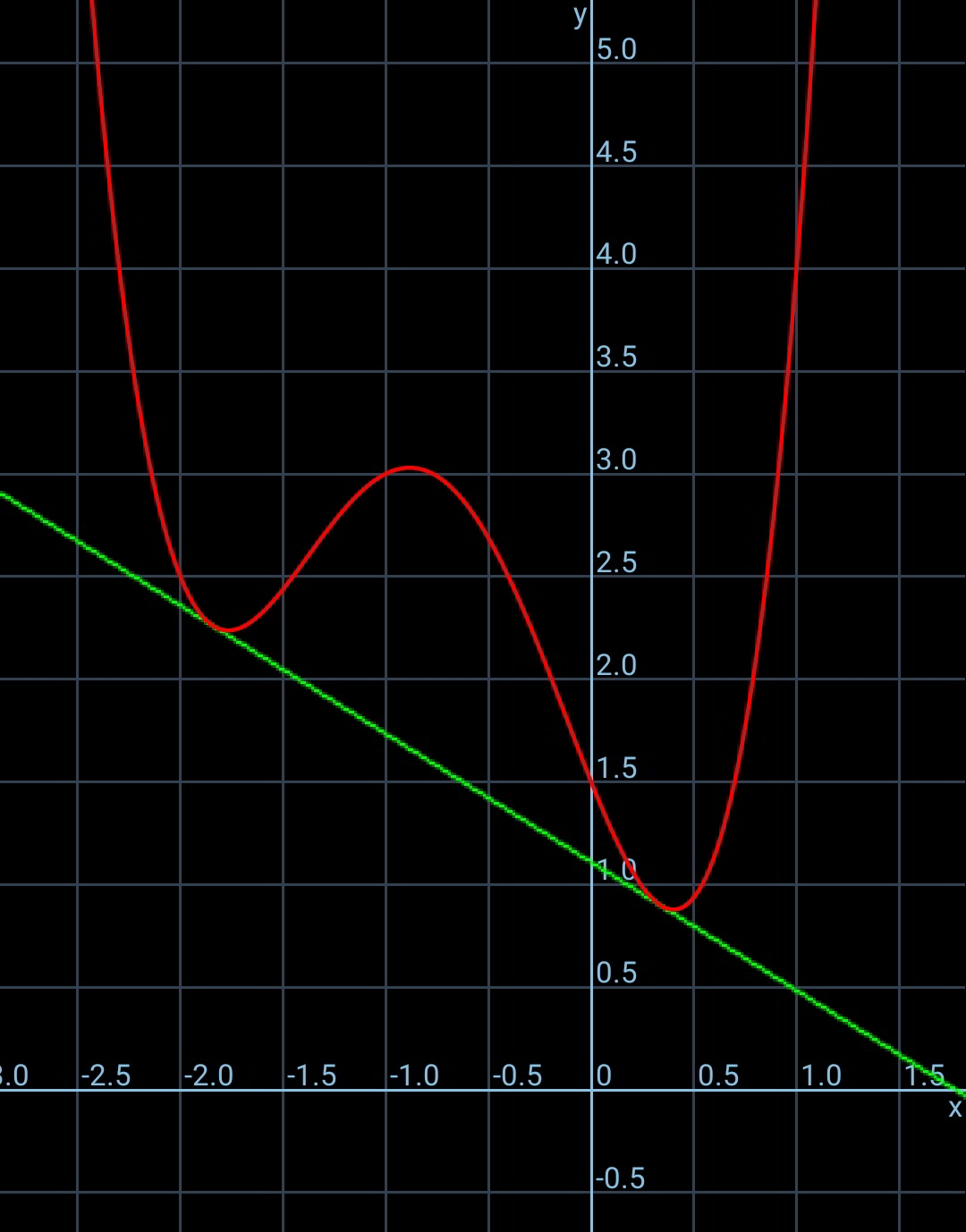
Commented by ajfour last updated on 27/Sep/19
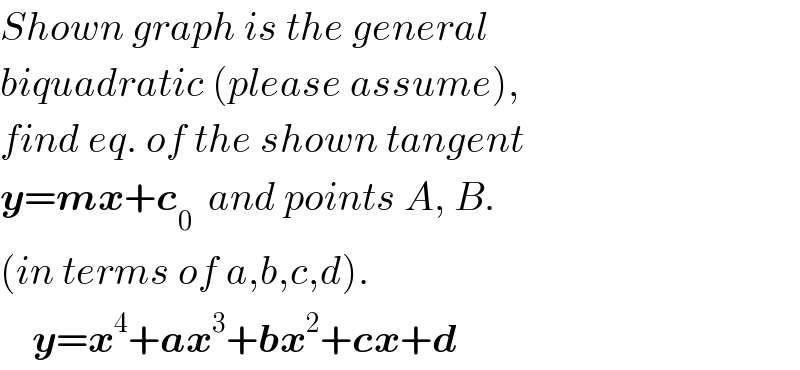
$${Shown}\:{graph}\:{is}\:{the}\:{general} \\ $$$${biquadratic}\:\left({please}\:{assume}\right), \\ $$$${find}\:{eq}.\:{of}\:{the}\:{shown}\:{tangent} \\ $$$$\boldsymbol{{y}}=\boldsymbol{{mx}}+\boldsymbol{{c}}_{\mathrm{0}} \:\:{and}\:{points}\:{A},\:{B}. \\ $$$$\left({in}\:{terms}\:{of}\:{a},{b},{c},{d}\right). \\ $$$$\:\:\:\:\boldsymbol{{y}}=\boldsymbol{{x}}^{\mathrm{4}} +\boldsymbol{{ax}}^{\mathrm{3}} +\boldsymbol{{bx}}^{\mathrm{2}} +\boldsymbol{{cx}}+\boldsymbol{{d}} \\ $$
Answered by mr W last updated on 28/Sep/19
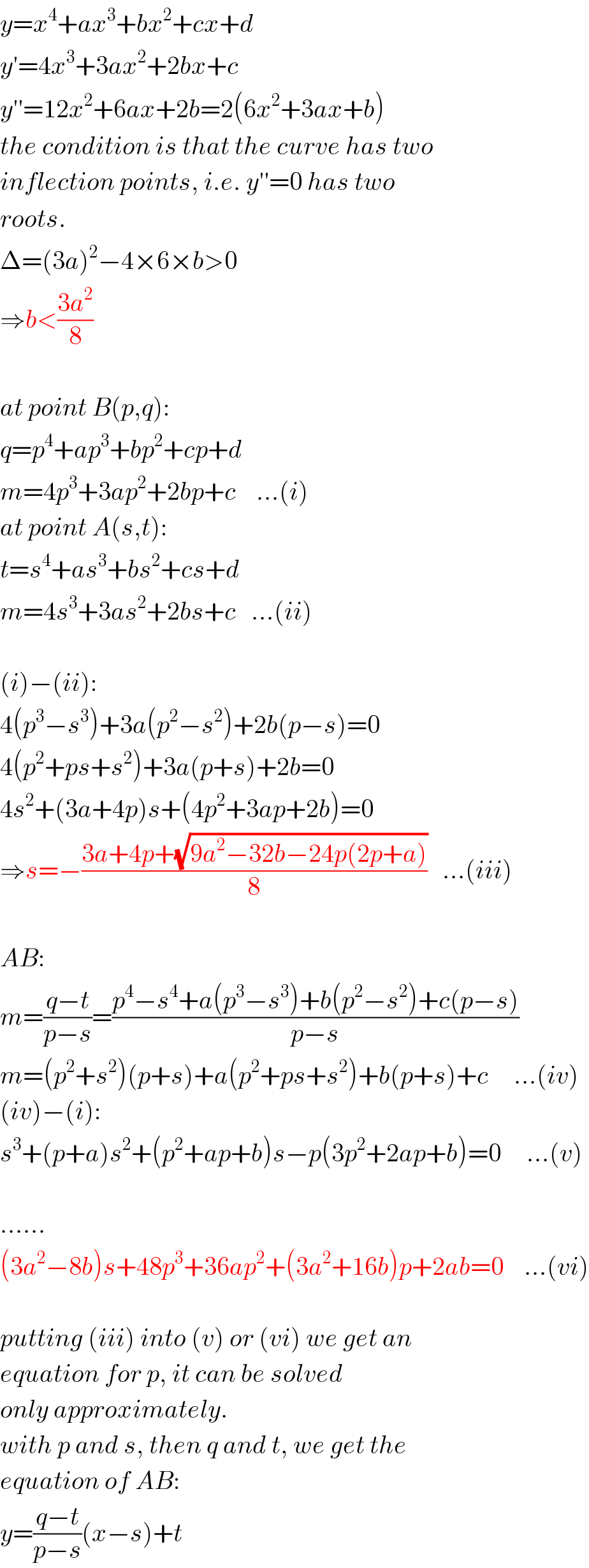
$${y}={x}^{\mathrm{4}} +{ax}^{\mathrm{3}} +{bx}^{\mathrm{2}} +{cx}+{d} \\ $$$${y}'=\mathrm{4}{x}^{\mathrm{3}} +\mathrm{3}{ax}^{\mathrm{2}} +\mathrm{2}{bx}+{c} \\ $$$${y}''=\mathrm{12}{x}^{\mathrm{2}} +\mathrm{6}{ax}+\mathrm{2}{b}=\mathrm{2}\left(\mathrm{6}{x}^{\mathrm{2}} +\mathrm{3}{ax}+{b}\right) \\ $$$${the}\:{condition}\:{is}\:{that}\:{the}\:{curve}\:{has}\:{two} \\ $$$${inflection}\:{points},\:{i}.{e}.\:{y}''=\mathrm{0}\:{has}\:{two} \\ $$$${roots}. \\ $$$$\Delta=\left(\mathrm{3}{a}\right)^{\mathrm{2}} −\mathrm{4}×\mathrm{6}×{b}>\mathrm{0} \\ $$$$\Rightarrow{b}<\frac{\mathrm{3}{a}^{\mathrm{2}} }{\mathrm{8}} \\ $$$$ \\ $$$${at}\:{point}\:{B}\left({p},{q}\right): \\ $$$${q}={p}^{\mathrm{4}} +{ap}^{\mathrm{3}} +{bp}^{\mathrm{2}} +{cp}+{d} \\ $$$${m}=\mathrm{4}{p}^{\mathrm{3}} +\mathrm{3}{ap}^{\mathrm{2}} +\mathrm{2}{bp}+{c}\:\:\:\:…\left({i}\right) \\ $$$${at}\:{point}\:{A}\left({s},{t}\right): \\ $$$${t}={s}^{\mathrm{4}} +{as}^{\mathrm{3}} +{bs}^{\mathrm{2}} +{cs}+{d} \\ $$$${m}=\mathrm{4}{s}^{\mathrm{3}} +\mathrm{3}{as}^{\mathrm{2}} +\mathrm{2}{bs}+{c}\:\:\:…\left({ii}\right) \\ $$$$ \\ $$$$\left({i}\right)−\left({ii}\right): \\ $$$$\mathrm{4}\left({p}^{\mathrm{3}} −{s}^{\mathrm{3}} \right)+\mathrm{3}{a}\left({p}^{\mathrm{2}} −{s}^{\mathrm{2}} \right)+\mathrm{2}{b}\left({p}−{s}\right)=\mathrm{0} \\ $$$$\mathrm{4}\left({p}^{\mathrm{2}} +{ps}+{s}^{\mathrm{2}} \right)+\mathrm{3}{a}\left({p}+{s}\right)+\mathrm{2}{b}=\mathrm{0} \\ $$$$\mathrm{4}{s}^{\mathrm{2}} +\left(\mathrm{3}{a}+\mathrm{4}{p}\right){s}+\left(\mathrm{4}{p}^{\mathrm{2}} +\mathrm{3}{ap}+\mathrm{2}{b}\right)=\mathrm{0} \\ $$$$\Rightarrow{s}=−\frac{\mathrm{3}{a}+\mathrm{4}{p}+\sqrt{\mathrm{9}{a}^{\mathrm{2}} −\mathrm{32}{b}−\mathrm{24}{p}\left(\mathrm{2}{p}+{a}\right)}}{\mathrm{8}}\:\:\:…\left({iii}\right) \\ $$$$ \\ $$$${AB}: \\ $$$${m}=\frac{{q}−{t}}{{p}−{s}}=\frac{{p}^{\mathrm{4}} −{s}^{\mathrm{4}} +{a}\left({p}^{\mathrm{3}} −{s}^{\mathrm{3}} \right)+{b}\left({p}^{\mathrm{2}} −{s}^{\mathrm{2}} \right)+{c}\left({p}−{s}\right)}{{p}−{s}} \\ $$$${m}=\left({p}^{\mathrm{2}} +{s}^{\mathrm{2}} \right)\left({p}+{s}\right)+{a}\left({p}^{\mathrm{2}} +{ps}+{s}^{\mathrm{2}} \right)+{b}\left({p}+{s}\right)+{c}\:\:\:\:\:…\left({iv}\right) \\ $$$$\left({iv}\right)−\left({i}\right): \\ $$$${s}^{\mathrm{3}} +\left({p}+{a}\right){s}^{\mathrm{2}} +\left({p}^{\mathrm{2}} +{ap}+{b}\right){s}−{p}\left(\mathrm{3}{p}^{\mathrm{2}} +\mathrm{2}{ap}+{b}\right)=\mathrm{0}\:\:\:\:\:…\left({v}\right) \\ $$$$ \\ $$$$…… \\ $$$$\left(\mathrm{3}{a}^{\mathrm{2}} −\mathrm{8}{b}\right){s}+\mathrm{48}{p}^{\mathrm{3}} +\mathrm{36}{ap}^{\mathrm{2}} +\left(\mathrm{3}{a}^{\mathrm{2}} +\mathrm{16}{b}\right){p}+\mathrm{2}{ab}=\mathrm{0}\:\:\:\:…\left({vi}\right) \\ $$$$ \\ $$$${putting}\:\left({iii}\right)\:{into}\:\left({v}\right)\:{or}\:\left({vi}\right)\:{we}\:{get}\:{an} \\ $$$${equation}\:{for}\:{p},\:{it}\:{can}\:{be}\:{solved} \\ $$$${only}\:{approximately}. \\ $$$${with}\:{p}\:{and}\:{s},\:{then}\:{q}\:{and}\:{t},\:{we}\:{get}\:{the} \\ $$$${equation}\:{of}\:{AB}: \\ $$$${y}=\frac{{q}−{t}}{{p}−{s}}\left({x}−{s}\right)+{t} \\ $$
Commented by mr W last updated on 28/Sep/19
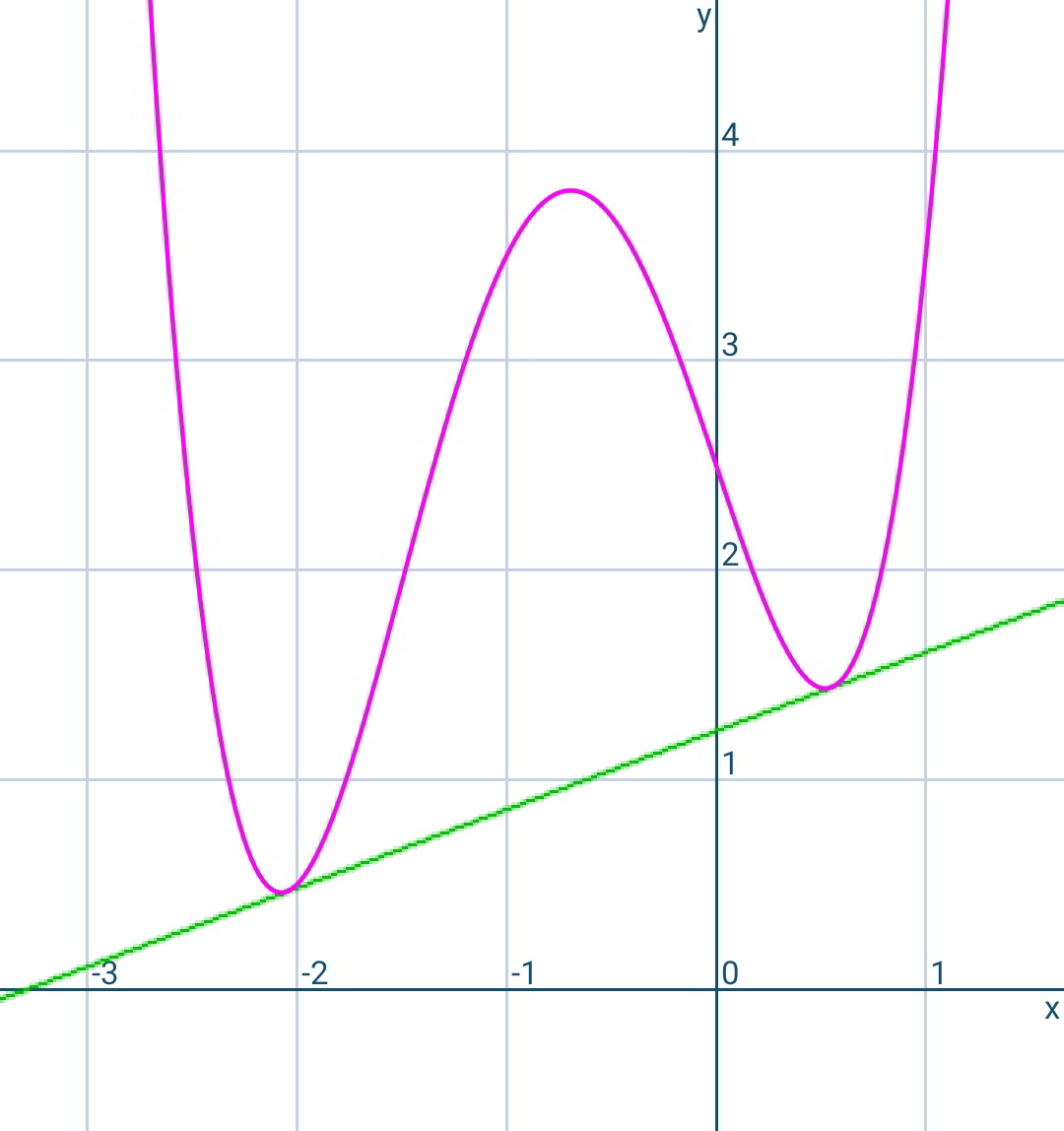
Commented by ajfour last updated on 28/Sep/19

$${Thanks}\:{Sir},\:{please}\:{view}\:{my}\: \\ $$$${attempt}.. \\ $$
Answered by ajfour last updated on 28/Sep/19
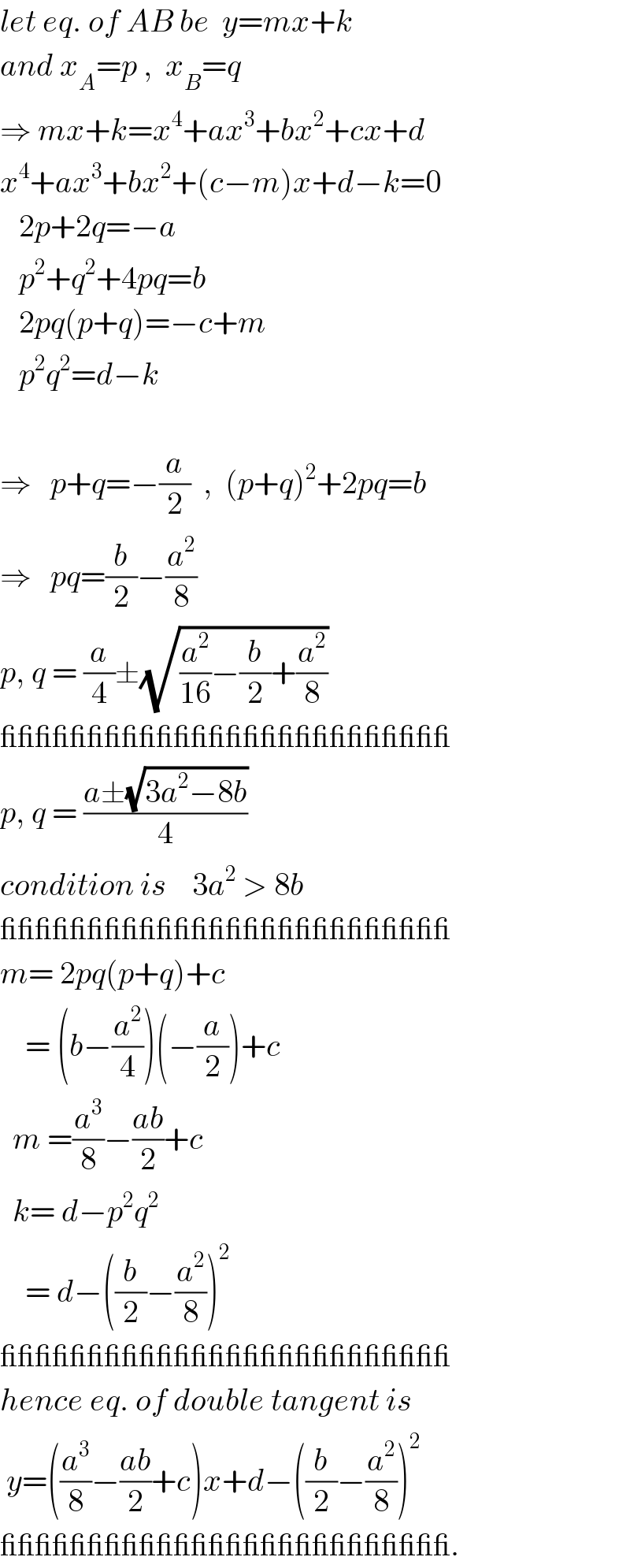
$${let}\:{eq}.\:{of}\:{AB}\:{be}\:\:{y}={mx}+{k} \\ $$$${and}\:{x}_{{A}} ={p}\:,\:\:{x}_{{B}} ={q} \\ $$$$\Rightarrow\:{mx}+{k}={x}^{\mathrm{4}} +{ax}^{\mathrm{3}} +{bx}^{\mathrm{2}} +{cx}+{d} \\ $$$${x}^{\mathrm{4}} +{ax}^{\mathrm{3}} +{bx}^{\mathrm{2}} +\left({c}−{m}\right){x}+{d}−{k}=\mathrm{0} \\ $$$$\:\:\:\mathrm{2}{p}+\mathrm{2}{q}=−{a} \\ $$$$\:\:\:{p}^{\mathrm{2}} +{q}^{\mathrm{2}} +\mathrm{4}{pq}={b} \\ $$$$\:\:\:\mathrm{2}{pq}\left({p}+{q}\right)=−{c}+{m} \\ $$$$\:\:\:{p}^{\mathrm{2}} {q}^{\mathrm{2}} ={d}−{k} \\ $$$$ \\ $$$$\Rightarrow\:\:\:{p}+{q}=−\frac{{a}}{\mathrm{2}}\:\:,\:\:\left({p}+{q}\right)^{\mathrm{2}} +\mathrm{2}{pq}={b} \\ $$$$\Rightarrow\:\:\:{pq}=\frac{{b}}{\mathrm{2}}−\frac{{a}^{\mathrm{2}} }{\mathrm{8}} \\ $$$${p},\:{q}\:=\:\frac{{a}}{\mathrm{4}}\pm\sqrt{\frac{{a}^{\mathrm{2}} }{\mathrm{16}}−\frac{{b}}{\mathrm{2}}+\frac{{a}^{\mathrm{2}} }{\mathrm{8}}} \\ $$$$\_\_\_\_\_\_\_\_\_\_\_\_\_\_\_\_\_\_\_\_\_\_\_\_\_\_ \\ $$$${p},\:{q}\:=\:\frac{{a}\pm\sqrt{\mathrm{3}{a}^{\mathrm{2}} −\mathrm{8}{b}}}{\mathrm{4}} \\ $$$${condition}\:{is}\:\:\:\:\mathrm{3}{a}^{\mathrm{2}} \:>\:\mathrm{8}{b} \\ $$$$\_\_\_\_\_\_\_\_\_\_\_\_\_\_\_\_\_\_\_\_\_\_\_\_\_\_ \\ $$$${m}=\:\mathrm{2}{pq}\left({p}+{q}\right)+{c} \\ $$$$\:\:\:\:=\:\left({b}−\frac{{a}^{\mathrm{2}} }{\mathrm{4}}\right)\left(−\frac{{a}}{\mathrm{2}}\right)+{c} \\ $$$$\:\:{m}\:=\frac{{a}^{\mathrm{3}} }{\mathrm{8}}−\frac{{ab}}{\mathrm{2}}+{c} \\ $$$$\:\:{k}=\:{d}−{p}^{\mathrm{2}} {q}^{\mathrm{2}} \\ $$$$\:\:\:\:=\:{d}−\left(\frac{{b}}{\mathrm{2}}−\frac{{a}^{\mathrm{2}} }{\mathrm{8}}\right)^{\mathrm{2}} \\ $$$$\_\_\_\_\_\_\_\_\_\_\_\_\_\_\_\_\_\_\_\_\_\_\_\_\_\_ \\ $$$${hence}\:{eq}.\:{of}\:{double}\:{tangent}\:{is} \\ $$$$\:{y}=\left(\frac{{a}^{\mathrm{3}} }{\mathrm{8}}−\frac{{ab}}{\mathrm{2}}+{c}\right){x}+{d}−\left(\frac{{b}}{\mathrm{2}}−\frac{{a}^{\mathrm{2}} }{\mathrm{8}}\right)^{\mathrm{2}} \: \\ $$$$\_\_\_\_\_\_\_\_\_\_\_\_\_\_\_\_\_\_\_\_\_\_\_\_\_\_. \\ $$
Commented by mr W last updated on 28/Sep/19
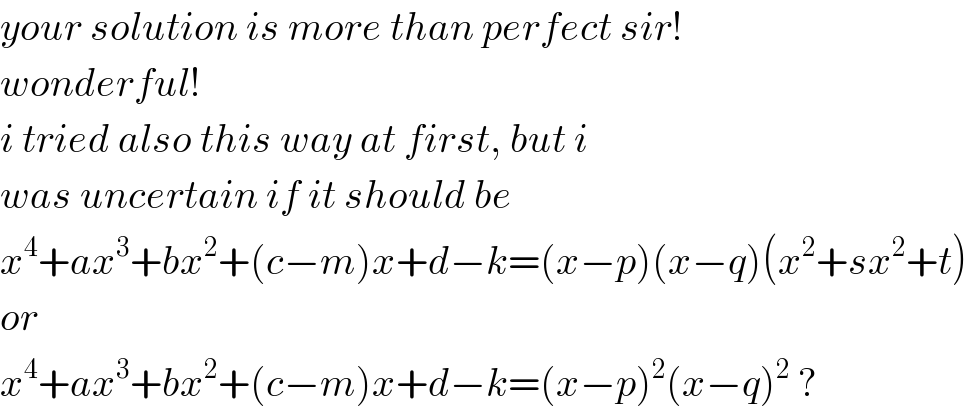
$${your}\:{solution}\:{is}\:{more}\:{than}\:{perfect}\:{sir}! \\ $$$${wonderful}! \\ $$$${i}\:{tried}\:{also}\:{this}\:{way}\:{at}\:{first},\:{but}\:{i} \\ $$$${was}\:{uncertain}\:{if}\:{it}\:{should}\:{be} \\ $$$${x}^{\mathrm{4}} +{ax}^{\mathrm{3}} +{bx}^{\mathrm{2}} +\left({c}−{m}\right){x}+{d}−{k}=\left({x}−{p}\right)\left({x}−{q}\right)\left({x}^{\mathrm{2}} +{sx}^{\mathrm{2}} +{t}\right) \\ $$$${or} \\ $$$${x}^{\mathrm{4}} +{ax}^{\mathrm{3}} +{bx}^{\mathrm{2}} +\left({c}−{m}\right){x}+{d}−{k}=\left({x}−{p}\right)^{\mathrm{2}} \left({x}−{q}\right)^{\mathrm{2}} \:? \\ $$
